Slip is basically Ikaruga with legs. This sole offering by the seemingly defunct Handsome Games (they and their website seem to have all but vanished after 2014) comes with a very reasonable $3.99 price for twelve fairly lengthy stages and a good bit of bonus content and polish. Outland may still be the king of color-swapping platformers, but there’s still enough to like here that the way in which Slip has so thoroughly ‘slipped’ under the radar really is unfortunate.
Anyone who has heard of Ikaruga will instantly be familiar with the core mechanics behind Slip. In addition to the standard ability of ‘being able to jump really high’ which nearly every platforming protagonist possesses, our cubic hero is capable of double jumping, wall climbing, and swapping between red and blue at the press of a button. Like in the shmup which popularized this colorful mechanic, bullets, lasers, and other hazardous projectiles are all color-coded and will not harm the protagonist while he matches their color. However, as this is a platformer there are also many platforms and spikes which will only appear as outlines until the player swaps over to their color. Performing rapid, split-second chains of color changes as you juggle between absorbing bullets, solidifying platforms, nullifying spikes, and performing all sorts of other interactions with red and blue environmental elements is at the heart of Slip’s gameplay and it can be fiendishly difficult.
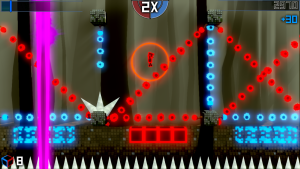
Though progression is linear, there is a bit more to each level than simply reaching the goal. Steve, an alien whose more realistic aesthetic deliberately clashes with the sleek, simplistic style of the protagonist, is the antagonist of the game and chases you through each stage while riding in a UFO equipped with a deadly purple laser, which serves as a soft time limit to force players to never stop for too long. Checkpoints are frequent and generally spread out well, which is great considering how the game is hard enough that my death count was in the triple digits in a few of the later stages, and each checkpoint boosts the score multiplier, though it will reset to the default upon death.
Speaking of the score multiplier, there is an online leaderboard, both for each level and for the game as a whole, and three difficulties to choose from; each difficulty boosts the game’s speed by 10% (so 120% on the highest difficulty) and this increase is certainly noticeable in a game which demands quick reflexes even on Normal, but the default score multiplier also increases with each difficulty so players will never drop below a 3x multiplier on the highest setting. For those really looking to chase top spots on the leaderboards, bonus points are gained whenever the protagonist absorbs attacks and making swift progress through a stage activates a temporary speed boost which, in addition to the obvious benefit of granting more speed, serves to further increase point gains while it is active. Cubes are also scattered across each stage which grant a temporary bubble of invincibility to the frail protagonist after 100 are collected and at least one bonus area exists in every stage where a particularly large number of these cubes can potentially be collected, but I found it to be difficult to actually collect enough cubes to get the shield in most stages and they ultimately serve primarily as another way to gather points.
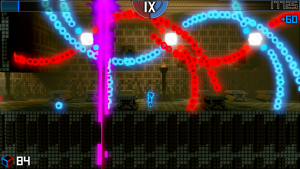
A person could probably finish Slip in about half an hour if they never died, but the difficulty ramps up enough that, even with the very generous checkpointing, two to three hours is a more realistic completion time. A large part of the difficulty comes from just how many obstacles and stage elements build around the color swapping mechanic and how they are combined together. For example, bounce pads exist which will shoot the protagonist in a specific direction as long as he is the matching color and these are normally used to cover wide gaps, but in one of the later stages strings of these bounce pads are placed on the ground and will bounce the protagonist straight into spikes on the ceiling and this challenge is further magnified by the presence of swarms of flame enemies, which hover in the air and can be destroyed on contact when matching their color, but they will grow and rapidly home in on the player when they are the opposite color. In this particular example, you need to readjust how you think about the previously-beneficial bounce pads and deliberately swap to the opposite color when crossing one while making sure to actually match colors with the flames in order to avoid being attacked while also never slowing down for more than a fraction of a second in order to stay ahead of Steve’s laser. Combinations like this one where you must simultaneously deal with obstacles which require the protagonist to match their color and obstacles where you must avoid matching colors are common and come in many forms to prevent the gameplay from ever feeling stale. Other hazards and contraptions along the way include mines which burst into bullets, Navi-like dive-bombing fairies, vortexes which allow the protagonist to stick to and swirl around them when he is their color and then fling him away when he shifts colors, and even gravity chambers which pull the protagonist in one direction or the other depending on his color. For a game with only a dozen stages and a single defining mechanic, three of which are focused almost entirely around boss fights, there are a surprisingly large number of different objects and enemies to deal with, all of which present a new twist on the simple concept of swapping between two colors.
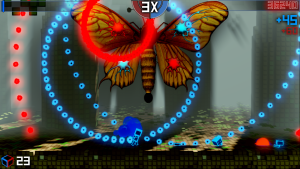
Boss fights actually account for a decent amount of the content in Slip. In addition to the final stage of each of the three areas focusing on a major boss fight with only a small amount of pre-boss platforming, there is a miniboss at the end of each of the nine other stages. Unlike other parts of the game, time pressure isn’t an issue as scrolling happens automatically in boss and miniboss fights alike and the only objective is to survive the sequence. Minibosses only ever have one type of attack, but they must usually be dealt with either while overcoming pits, spikes, and walls or while fought alongside another miniboss, such as in the case of a rotating orb with a red laser on one side and a blue laser on the other side which is paired up with insects which fly through the air while dropping strings of blue and red bullets. Major boss fights are much more involved as these bosses each have three different types of attack sequences and, with the exception of the first of these bosses, they cycle through several variants of these attacks over the course of the fight.
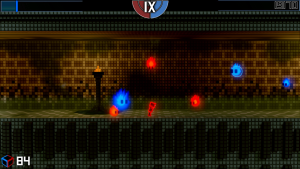
On the whole, I enjoy Slip’s high level of difficulty, but there are a few issues which come about due to its challenging nature, most of which relate to its bosses. Though the difficulty falls under ‘brutal yet fair’ for most of the game, some parts of the last three stages (including the final boss in particular) feel like they demand sequence memorization even on the default difficulty. Bosses have a checkpoint after each attack sequence, but fights against minibosses do not contain checkpoints and some fights can take about a minute. A minute may not sound long for a fight, but the autoscrolling nature of these fights means there is no way to make them go faster and, between minibosses always using the exact same attack sequences on each attempt and the fact that some of these fights can take upwards of a dozen or more attempts to successfully complete, the first half of that minute can start to feel extraordinarily tedious. I found slowdown to also be an issue in a handful of the later segments, though the worst instance of this by far occurs during the second boss fight where, even on the lowest settings, the frame rate felt like it would sometimes drop into the single digits during an attack involving a particularly large number of bullets. Respawn time is also a slight issue as it can take about two or three seconds which, while still fairly fast, is definitely felt and breaks up the momentum in a game where it is easy to die multiple times per minute.
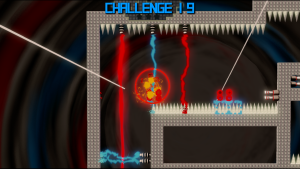
Aesthetics and extra content are both mixed bags. Extra content consists primarily of unlockable aesthetics tide to achievements and twenty small challenge rooms; neither of these things are poorly done, but the lack of a leaderboard for the challenges makes them lack the replay value of the main game and it would have been nice to see a bit more in the way of substantial bonus content. As to aesthetics, I think the visuals are great and I particularly like how the stylistic contrast between Steve and the protagonist extends to the game as a whole with the vibrant cubic landscape around the protagonist’s house gradually give way to environments which are dull, dead, and more realistically proportioned as you draw closer to Steve’s territory. I also particularly like the aesthetic used in the bonus areas as the ground in these segments is made up of hundreds of small cubes which gradually fall away as a neat way to visually represent the time limit.
Music, on the other hand, is not bad, but it all sounds like it was made more for a trailer than for the actual game. The soundtrack, despite including elements of dance and dubstep, is remarkably calm and relaxed and, indeed, it would work if a player was in the middle of a perfect run, flawlessly slipping between colors as they effortlessly overcome traps and foes with split-second accuracy. As it stands, the more realistic Slip experience is a frenzied cycle of death and rebirth as you desperately try to keep track of multiple obstacles and hazards while narrowly avoiding being run over by Steve’s laser. To say that there’s a disconnect between the tone of the music and the general flow of the gameplay would be quite the understatement.

Slip is not a perfect game, the difficulty feels unfair in some later segments, boss fights tend more towards tedium and frustration than fun, and not all of its parts fit together perfectly. It is, however, still an experience which is enjoyably challenging for the vast majority of its length and one which offers up a great amount of replay value for anyone looking to chase a top spot on the leaderboards while also inventive some wonderfully creative uses for a mechanic I wish we saw more of.